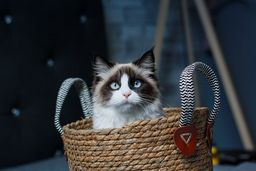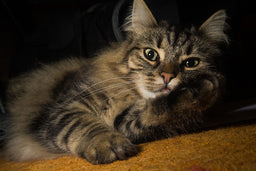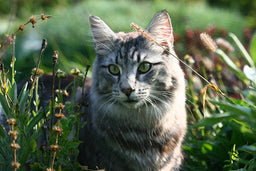Laidback or demanding—what is a Russian Blue cat like? Get to know them inside out!
A Russian Blue (RB) is the first choice for many people looking to add a pretty, grey kitty to their household. One look into an RB’s captivating emerald eyes is all you need to go mad for them!
Before you rush into adopting one, you should understand the demands of raising a Russian Blue cat. Will your current lifestyle complement this breed’s upkeep and engagement needs, and what specific health factors should you consider when planning their diet?
The good news is that the Russian Blue is a mild-tempered, low-maintenance breed suitable for single owners and large families. We have prepared a compact guide covering all bases about nurturing these stunners the best way. You’ll learn about:
- A Russian Blue cat’s features and personality traits
- Your parental responsibilities
- The best cat food products tailored to support your companion’s long-term health
The history of Russian Blue cats
The Russian Blue’s breeding origin is unknown, but it’s believed that these cats came from natural breeding and were domesticated by the Russian aristocracy. Russian folklore describes them as royalty favourites as they were supposed to bring a healing presence and good fortune to kingdoms.
Around the 1860s, UK sailors visiting the port of Archangel in Russia began taking these unique kitties to Great Britain and Northern Europe. The RBs initially had no breed-specific classification in the UK and were usually referred to as Archangel Blues, Foreign Blues, and the Maltese.
Over the next few decades, Russian Blues gained prominence on various cat shows in London. They were eventually named and introduced as a separate breed in 1912. The breed almost got extinct during World War II, but a few breeders from England and Scandinavia preserved its lineage.
Several Russian Blues were taken to the U.S. during the post-war period, where they were crossbred with other cats like the Siamese. That’s why American RBs have more oriental features. Keep in mind that many breeders try to pass off mix-breeds or even similar breeds like grey British Shorthair and Burmese as RBs. You should learn how to identify a Russian Blue cat to ensure you’re getting the right pedigree if you are specifically looking to adopt a purebred cat.

They call me a good luck charm, but I’m more of a do-no-harm kitty!
Source: John Brighenti
The Russian Blue cat—physical characteristics
The Russian Blue cat is not your average grey kitty. Everything about them screams unique—from their coat texture to body type! The following table summarises the defining physical characteristics of Russian Blue cats:
|
Physical feature |
Description |
|
Body type |
Russian Blues have a distinctive body type that’s a mix of slender and stocky. Healthy adults have a slim physique like Siamese and Abyssinian cats. You can see an RB’s elegant neckline, high-set shoulder blades, and carved, long limbs as they walk. But once seated, Russian Blues appear cobby-bodied like the British Shorthair because of their compact musculature |
|
Face shape |
The facial features of a Russian Blue are angular, much like Korat and Savannah cats. They have:
|
|
Eyes |
Russian Blue kittens have yellow-hued eyes, but they develop green rims around their pupils after a few weeks. By six months, most RBs have dazzling, green eyes |
|
Nose and paw pads |
This breed has:
|
|
Coat |
Russian Blues have:
|
|
3.6 to 6.8 kilos |
|
|
Measurements |
|
Why is a Russian Blue’s double coat special?
Blue-grey short-haired cats are fairly common. Many breeds like Maine Coons, Norwegian Forests, and Persians have double-layered coats as well, so how does a Russian Blue’s coat stand out?
Luckily, you can easily recognise a purebred Russian Blue’s coat because it’s:
- Extremely dense—It’s hard to see their skin even if you part sections of the fur
- Super short and velvety—You can draw patterns on an RB’s coat with your fingers and smooth everything out with a stroke (most grey cats have coarse and woolly coats)
- Solid-coloured but accented with a lighter shade at the tip—this gives the signature bluish-silvery sheen to their body

I think my hooman’s obsessed with my coat. How else would you explain the constant touching? Perhaps, I don’t mind!
Source: Giovanna Karla (givi)
The personality of a Russian Blue cat
There are opposing opinions on Russian Blues’ temperament. For example, many people say that RBs are cuddly, while some swear that they hate being picked up—so, what’s the truth?
Like all cats, Russian Blues are individualistic, but their behavioural patterns usually reflect the following traits:
- Introversion—Russian Blues are your classic shy and quiet kitties. While deeply attached to their family members, they may appear aloof to strangers. They can be overwhelmed by persistent friendly advances from other humans or pets, but their primary instinct is to run away to another room rather than respond aggressively
- Creatures of habit—RB’s love for familiarity makes them ritualistic. They prefer:
- Having meals at preset times
- Playing with specific toys only
- Hanging out at the same spots
- Affection towards particular human(s)—RBs are highly committed to their humans. They may bond with one family member more than the others and follow them around the house like shadows. Russian Blues are attuned to the feelings of the humans they adore, so they may cuddle with you or give you space depending on your current emotional state
- Intelligence—This breed displays strong visual-spatial and emotional intelligence. They can:
- Open drawers to locate stuff
- Stay composed when stressed
- Have a general understanding of acceptable and unacceptable behaviour
- Service-mindedness—Russian Blues want to be helpful to their humans, which makes the training easy. The rewards should be encouraging words and not treats
The lifestyle that suits a Russian Blue cat’s temperament—male and female
A Russian Blue’s temperament exudes independence, sharpness, and grace, so they can handle themselves well without constant supervision. Males and females exhibit similar behaviour, although toms tend to act slightly needy till they are neutered.
We have prepared the following Q&A table to help new cat parents raise Russian Blues:
|
Question |
Answer |
|
Russian Blues, like Sphynx and Ragdoll cats, are hardcore indoor kitties. They enjoy occasional outdoor trips and short sun-bathing sessions in the garden as long as their human is around. Be careful when you take them outside, as they may get fixated on mice, frogs, and insects and run away chasing them |
|
|
Are Russian Blue cats good with dogs and other cats? |
RBs are polite to other animals but can be territorial and may not engage with them. Russian Blues who are socialised with other pets from kittenhood grow up to be affectionate and considerate toward them |
|
Are Russian Blue cats kid-friendly? |
This breed is gentle, protective, and cautious around kids. They’re mindful of sleeping toddlers and try to keep their vocalisations mellow |
|
How long should a Russian Blue cat’s playing time be? |
Russian Blue cats are moderately active and need about 20 minutes of play-time every day to maintain their athletic physique and avoid unhealthy weight gain |

My hoomans are my besties, and their welfare is what makes me tick. I’ll protect what they like and try to say hello to whatever creature they need me to.
Source: Jelena Senicic
Life expectancy of a Russian Blue cat and common health problems
A Russian Blue’s average lifespan is between 13 to 20 years, but some have lived till the ripe old age of 25!
In general, purebred Russian Blues have no genetic problems, but they are prone to developing the following illnesses due to old age or poor lifestyle and food choices:
- Hyperthyroidism—Russian Blues are genetically at risk of developing hyperthyroidism once they are 8 years and older. The hormonal disorder can be stabilised with medication if detected on time. Cats with the disease display symptoms like:
- Voracious appetite and weight loss
- Hyperactivity
- Vomiting and diarrhoea
- Diabetes—Diabetes is common in RBs on a dry-food diet because kibble usually contains too many carbs like sugar, corn, and potato concentrates. A high-carb diet (more than 3% carbs) causes insulin resistance and can also trigger other issues, such as:
- Chronic obesity
- Gastrointestinal problems (IBS, constipation, etc.)
- Heart disease
- Renal disease—A Russian Blue’s kidney function can deteriorate with age, even faster if they consume only dry food and don’t drink enough water
- Cystitis—Senior Russian Blues tend to get cystitis, an inflammatory condition of the lower urinary tract caused by bladder stones, tumours, or infections
- Progressive retinal atrophy—PRA is an old age-related disease that leads to gradual vision loss, but most Russian Blues cope with it well if they live in familiar surroundings

Has your RB been feeling out of sorts lately? Best to make that trip to the vet.
Source: Bruno Henrique
How to prevent common health issues in Russian Blues
To preserve the long-term health of your Russian Blue, pay attention to:
- Regular health check-ups and vaccine shots—Annual or half-yearly vet visits will help your Russian Blue stay one step ahead of potential medical issues. Rush your kitty to the vet immediately if they:
- Refuse to eat food for more than a day
- Keep throwing up food or have the runs for more than three days
- Get sick and lethargic after eating toxic food (like onions, spoiled eggs, etc.)
- Their lifestyle—While Russian Blues are not lazy, they’re also not super energetic like Bengal and Siamese cats. They may embrace a sedentary lifestyle if you don’t encourage them to exercise. Ensure they spend enough calories daily by:
- Playing fetch or learning tricks outside
- Using climbing or sprinting indoor toys, such as cat towers, lasers, and catnip-infused toys
- A nutritious meal plan—Russian Blues may look dainty, but they have heavy bones and robust muscles that can only be maintained with high-protein meals. Their food should contain more than 50% protein and less than 20% healthy fats. RBs must absorb these nutrients from meat as they are true carnivores. Vegetables and grains will only stress their digestive tract and fail to deliver essential nutrients
Most vets recommend a lean-meat diet for Russian Blues, so opt for top-notch wet food that’s free from grains, meat derivatives, and other useless fillers.
Keep your Russian Blue in top condition with Untamed
If you want the best food with high-quality ingredients for your RB, try Untamed. We only use human-grade whole meat and fish in our products. Our gravy and jelly formulas are made with 60%–63% lean meat without iffy additives, including:
- Vegan protein
- Sugar
- Grain
- Animal derivatives
- Harsh preservatives
- Artificial flavour enhancers

Russian Blues march ahead like champions to claim that succulent plate of Untamed!
Image (c) Untamed
Our products offer Russian Blues two times more protein than the average supermarket-bought cat food. We have worked with vets to create recipes that deliver taurine, Omega-3 fatty acids, and other good stuff in optimal quantities. With the right doses of vitamins and minerals in their system, your Russian Blue will enjoy:
- Great digestive health
- Resilient bones and muscles
- Balanced energy levels
- Healthy eating habits
- Optimum brain function
Every kitty loves Untamed!
Our food works for all cats irrespective of their breed or life stage! Healthy cat food is useless if it tastes anything less than yummy. Untamed food is delicious because we:
- Gently steam the meat—Steaming neutralises all pathogens in raw meat, making it safe for your kitty. The process also:
- Helps food retain its original nutrients and enzymes
- Softens meat and makes it easily digestible
- Improves the texture, taste, and aroma of the ingredients
- Test our products on fussy kitties—If your kitty has refused wet food before, Untamed will change their mind. When picky eaters try our meals, it’s bowls-licked-clean every time!
- Stick to allergen-free ingredients—We don’t add ingredients known to cause allergies or stomach sensitivities in pets
- Offer variety—We keep the menu interesting for your kitty with our various single- and multi-protein options, including:
Take our TRY NOW quiz to tell us about your kitty’s meal preferences and order our trial pack at a special price!

Fillers can fly to fillerland—upgrade your kitty’s health with appetising, well-cooked whole meat natural to their digestive system.
Image (c) Untamed
Untamed—keeping Russian Blues fit and happy!
Untamed is made for all kitties, so there’s no stress of switching products. Here’s how we promote feline health at every life stage:
- Kittenhood—Kittens have high caloric requirements and require high-protein meals. Get your kitty started on 2–4 cans of Untamed after they’re weaned off. They will hit the necessary weight and growth markers with no tummy troubles
- Adulthood—A balanced Untamed diet in adult cats helps prevent illnesses like diabetes and obesity. Our food keeps your kitty naturally hydrated, which optimises renal functions
- Senior years—Most cats experience a decrease in appetite as they age. Our meals can help manage their weight and prevent stomach upsets
Based on the feedback from our clients, here’s how Untamed gradually improves the health of felines:
|
Timeline |
The Untamed effect! |
|
Week one |
|
|
Month two |
|
|
Month three |
|
|
For life |
|
Let your Russian Blue explore Untamed’s menu—get our handy trial pack!
Order our trial box online and watch your kitty go wild about our meals! All you need to do is:
- Visit our TRY NOW page and complete the short questionnaire
- Select a meal plan
- Order the trial box
You'll get the goods in a day with zero shipping fees. Once your Russian Blue decides on their favourite dishes, you can get scheduled monthly supplies delivered to your door. The terms of the subscription are flexible—log in to your Untamed account to:
- Modify your meal selection
- Postpone or cancel a delivery
Untamed is a carbon-neutral brand—we use recyclable packaging and:
- Buy meat from cruelty-free suppliers
- Get seafood from dolphin-safe sources

Always the winner dinner—tame your kitty’s food habits with Untamed!
Image (c) Untamed
Practical grooming tips for Russian Blues
Russian Blues are suitable for allergy sufferers as they don't shed excessively and produce less Fel d 1 (the major cat allergen) than average cats. They’re also actively into self-grooming, so they don’t get dirty often. While you don’t have to brush or bathe your RB every day, it’s smart to follow these basic hygiene tips:
- Brush them once every week and twice during shedding seasons (early spring and fall)—use a fine-toothed comb
- Clip their nails every two weeks
- Clean their teeth ideally every day. You can also offer them dental chews that help prevent plaque accumulation
- Bathe your Russian Blue with a hypoallergenic shampoo once every four to six weeks—apply lukewarm water with a spray hose to avoid letting water into their ears and nose
- Use an ear cleaning solution to remove dirt or foreign objects from your kitty’s ears



